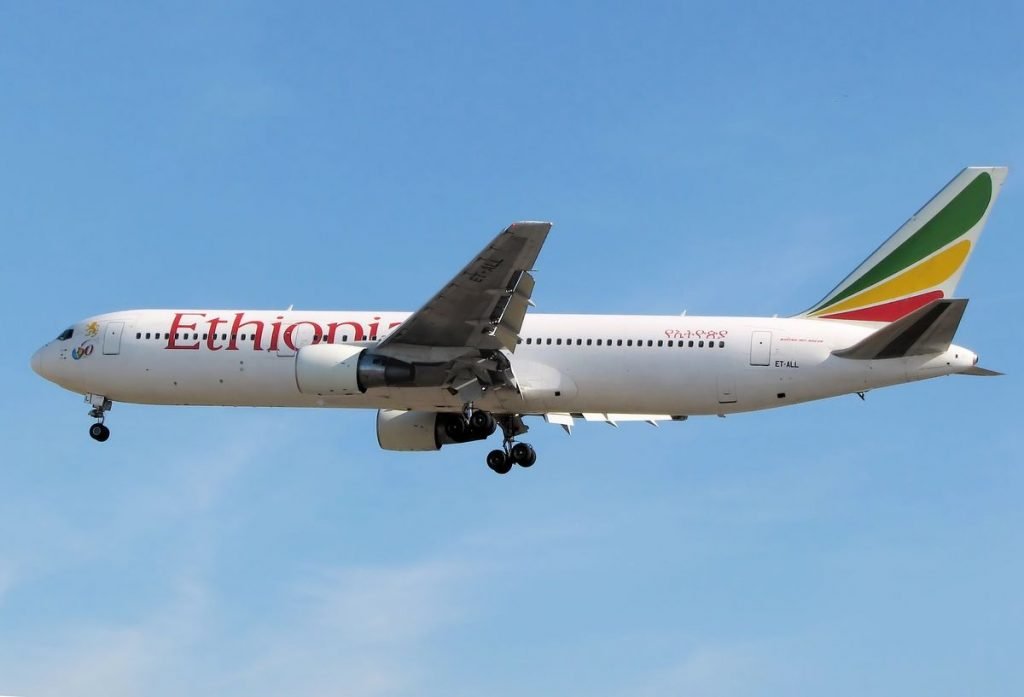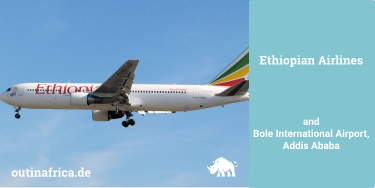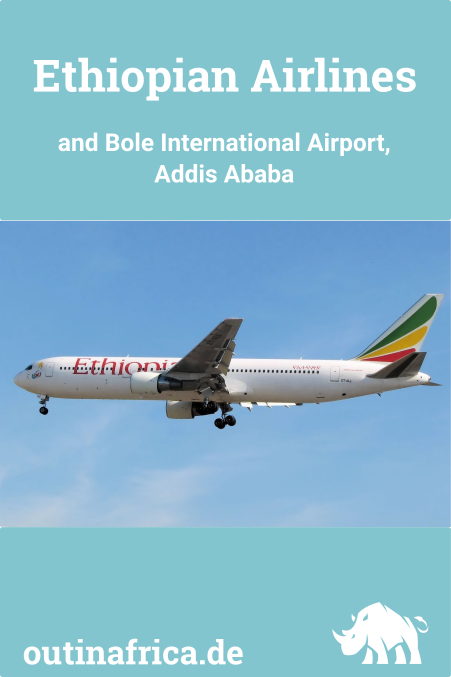This post is also available in:  Deutsch (German)
Deutsch (German)
Are you planning a trip to Namibia or elsewhere in Africa and are you looking for a suitable airline? Are you wondering how Ethiopian Airlines compares to other airlines?

In the following, I will write about my flight with Ethiopian Airlines from Frankfurt to Windhoek and about my experiences at the Bole International Airport in Addis Ababa.
Why I flew with Ethiopian Airlines
In November 2018 I had to travel to Namibia for ten days. I arranged the trip at short notice. While looking for a flight, Ethiopian Airlines stood out because of the low price, at the other airlines it cost more than 1000€ to get there and back. Ethiopian Airlines, on the other hand, was in the mid-three-digit euro range. The flight would not be a direct flight to Windhoek, it would stop in Addis Ababa, but would not take too long – 14 instead of 10 hours. At the Bole Airport in Addis Ababa, I would stay for two and a half hours. Then it would go on to Windhoek. The alternatives, with a stopover in Johannesburg, took longer (often more than 24 hours) and were not cheaper than a direct flight with Air Namibia.
Anita and I researched the airline on the Internet. Ethiopian Airlines is, according to Wikipedia, the largest airline in Africa – the most passengers, planes, destinations and the largest revenue. The airline is also a member of the Star Alliance. There were no catastrophe reports about the airline itself, but Bole International Airport was supposed to be an imposition: Much too small for the rapidly growing passenger volume. There was much discussion about chemical toilets and of chaos to find the right gate. But I can take two hours of terrible circumstances.
My most important criterion when selecting an airline is the seat distance. Ethiopian Airlines says it’s 82 cm. That’s enough for my long legs.
I had read that you could take two times 23kg luggage. This generous baggage allowance also speaks for the airline.
Addis Ababa… At school, we learned the geography of Africa and my mother had practised with me the capital and other important cities. We couldn’t decide whether we liked “Addis Ababa” or “Dar es Salaam” more. I love to visit cities whose names I find beautiful and so far it has always been worth it. And now I could fly to Addis Ababa. I would only be in the airport building, but perhaps I would also see something of Ethiopia from the air.
Booking and Check-In
I booked the flight. I made the reservation without any problems over the Internet. However, suddenly it was said that only one piece of luggage of 23kg was allowed. Now, how? The 2x23kg was not so crucial for me, at least not on this flight, and I decided to go without a second suitcase.
The online check-in also functioned, but I couldn’t reserve a seat. I was automatically assigned a window seat for both sections of the route. During the day I like to sit at the window, but the part Frankfurt-Addis Abeba is at night, and then I prefer to sit at the aisle. But I was able to change that at the luggage check-in in Frankfurt. For the route Addis Ababa to Windhoek I kept the window seat. At the luggage check-in, I noticed that I could have taken 2×23 kg with me.
According to the website, the counter at the airport should open three hours before departure. The flight was supposed to start at 21:30, so I expected the desk to be operational at 18:30. I was early and positively surprised that I could check in at 18:00 o’clock. Since I only wanted to check in my luggage, I quickly found a separate counter. Here I was able to change to a different seat in the aisle.
The flight to Addis Ababa
Boarding started very punctually, and I was welcomed on the Airbus A350-900 by friendly flight attendants. On most flights to Namibia, the seating is in Economy Glass 2-4-2. Here it was 3-3-3. The aisles are noticeably narrower than usual, but the seats are comfortable, and the seat spacing is more than sufficient for me as a long person.
The machine still looked very new and clean. The airline’s fleet is said to be very modern.
In the in-flight magazine, I read more about Ethiopian Airlines. In the financial year 2017/2018, the airline had
- Purchased 14 new aircraft, making it the first and only airline in Africa to have more than 100 aircraft in service.
- Eight new destinations opened up
- 21% growth in passengers
- 43% growth in revenue
- 18% more freight carried
SKYTRAX, the organisation that rates customer service of airlines, gave the airline four stars. SKYTRAX also awarded Ethiopian Airlines “Best Airline in Africa”, “Best Business Class in Africa” and “Best Economy Class in Africa”. Of course, this article about the airline in the airline’s in-flight magazine is mainly marketing and self-adulation, but it gave me a good feeling to have chosen it for my trip. I was thinking of Air Namibia, which is continuously in the red and is only saved from bankruptcy by taxpayers’ money, and I asked myself why they didn’t manage to operate a commercial airline.
Dinner on long-haul flights is not necessarily something that makes me excited. My stomach often rebels when I open the heated aluminium boxes, and the smell of chicken or beef hits me. The Ethiopian Airways dinner surprised me pleasantly. There was a choice of pasta or fish, and I chose pasta. I was handed a big tray. On it was the aluminium box with the cooked meal, a salad with extra French dressing, crackers, a processed cheese spread, a roll and butter and a dessert with cheesecake. Maybe I have been flying too many cheap airlines lately, but the size of the meal surprised me.
The second surprise was the quality of the food. I wouldn’t be astonished if I had heard that the lettuce was still on the farm in the morning, it was so fresh. The pasta was al dente, and with it, there were peas and carrots and a dash of tomato sauce – precisely as I like it. Anyway, I ate with pleasure. When can you say that about a meal on a plane?
The flight route was from Frankfurt, via Austria, the Balkans, Greece, the Mediterranean, Egypt, the Red Sea (to fly around Sudan), Eritrea and Addis Ababa, Ethiopia.
The film selection disappointed me a bit concerning the up-to-dateness. There were no new movies, but the .selection was extensive. However, many of the films had no German soundtrack, and I had to watch mine in English.
Announcements during the flight were always in Ethiopian and English.
After the overheated airport buildings, the onboard climate was quite cold. I put on a fleece sweater in addition to my long-sleeved shirt.
I always sleep very poorly on planes. The same here, but I overslept the wake-up coffee. The friendly staff promised to bring me some. After all, we were flying over Ethiopia – the motherland of coffee. Unfortunately, we went into the landing approach, so that I didn’t get my coffee anymore.
Bole International Airport, Addis Ababa
We landed early in the morning at 6:00 a.m. (4:00 CET) at Bole International Airport in Addis Ababa. Now I was curious whether the airport was as terrible as it was reported to be on the internet. During the flight, I had read in the flight magazine that the first part of the new terminal had just been put into operation and assumed that it wouldn’t be quite so bad.
I arrived in the old part of the airport, and despite the early hour, it was very crowded. Travellers sat on the floor with their luggage, and it was not always easy to find a way. But it is a large airport with duty-free shops, restaurants and also proper toilets. The temporary toilets, which were probably built later because of the masses of people, were also standard toilets. Toilet paper was not always available in the cabin itself. But then there were some rolls in the anteroom, and I could take enough paper with me. There was also staff who tried to keep everything clean.
There were even washbasins where worshippers could wash their feet before going into a prayer room for men or women.
I went through some duty-free stores. It’s worth it. For example, smokers can buy a carton of cigarettes for 12 US$. There were a lot of Asian travellers. A Chinese man bought twenty cartons of cigarettes and a small suitcase to transport his purchases — also, a great deal of coffee sold in the duty-free shops: as beans or ground, in various degrees of roasting, Fairtrade or not. Apart from coffee and tobacco products, the usual duty-free products such as alcohol, sweets, perfumes, etc. are also sold.
The currency at the airport is US dollars. You can also pay with Euro, but then it gets complicated as the cashier has to use a calculator. I had bought a few US dollars in Frankfurt, which made life much more comfortable.
I went to a restaurant, took a coffee and used the free WiFi to send a message to family and friends.
I found the airport building fine, but I can also understand if someone does not feel comfortable there. Ethiopian Airlines is proud to have a 21% increase in passengers, but they all have to go through the building.
After the coffee, I wanted to find out where the gate for the flight to Windhoek is located. I was addressed in English by a helpful young man who explained to me that I had to go through the security check first and then down a hallway to the new building.
The security check is as we know it. Computers, cameras, tablets or any toiletry bags must be removed from hand luggage and placed in baskets. All pockets in the clothing must be empty. Contrary to Frankfurt I even had to take off my shoes and belts.
I went further down the hallway, around the corner and suddenly I was in the new terminal building and a different world. Much fewer people walked around, it was quiet, and the toilets were brand new. But there were no shops or restaurants in the new building yet. According to the Ethiopian Airlines in-flight magazine, the first phase of the new terminal had just opened. Next year, the entire terminal with restaurants, duty-free shops, etc. will go into operation and accommodate up to 22 million travellers per year. With the new terminal, the airport will be the largest airport in Africa, more extensive than O.R. Tambo in Johannesburg.
On to Windhoek
The boarding for the second stage of my journey was punctual and well arranged. This time I flew a B787.
I sat at the window and thought for the longest time of the Boarding that I would be alone on the triple row. But I was disappointed because a group of disabled people and their assistants were boarded the plane at the very end. A disabled man and his attendant sat next to me. I was stuck in a corner, but at least I could look out of the window.
At first, there was not much to see because of clouds, but from Kenya on it became interesting. The clouds disappeared, and a rugged desert around the Lake Turkana was visible. Then we travelled south along the Rift Valley. Lake Nakuru, the Ngorongoro Crater and the Serengeti opened up on my side of the plane. I even disturbed my neighbours for Kilimanjaro on the other side of the aircraft, got up and went to a free window on the port side. The highest mountain in Africa was shrouded in clouds.
It’s not like I was the only one who bothered the other passengers. My neighbour wanted to see the Ngorongoro crater and always leaned past me. I asked him if he wanted to switch seats: he could sit at the window, his friend in the middle and I at the aisle. He declined the offer. When we had passed the Serengeti, the view was not so exciting anymore, and he took a nap.
The route from Addis Ababa to Windhoek was via Kenya, Tanzania, Zambia, Botswana and Namibia. The Democratic Republic of the Congo was circumnavigated.
Conclusion
I will not describe the return flight from Windhoek to Frankfurt via Addis Ababa here. It was about the same as the outbound flight. But I managed to get a seat at the window with an empty seat next to me for the Windhoek-Addis Ababa route. For the section Addis Ababa-Frankfurt I had an aisle seat.
So let’s draw a short conclusion:
If I have anything to complain about Ethiopian Airlines, it’s the 3-3-3 seating. Not only does this make a window seat unattractive for me as it gives me a feeling of claustrophobia that even the most beautiful view cannot make up for. It also makes the aisles very narrow, so you have trouble getting your board case to your seat.
Then I also have to complain that you can’t choose a seat during the online check-in. Perhaps this possibility was only temporarily deactivated?
But Ethiopian Airlines does not have to hide at all. The planes are modern, the service excellent, the flights punctual. Well, the last four hours longer due to the detour via Addis Ababa and the two and a half hour stay there. But if you fly via Johannesburg to Windhoek, it takes just as long or even longer. At that time, tickets for a return flight cost less than 600 euros. It was worth it for me to fly with Ethiopian Airlines. If the new terminal at Bole International Airport is put entirely into operation, the stay there will also be much more pleasant.
Links
- Website of Ethiopian Airlines
- Addis Ababa surges as Sub-Saharan travel gateway
- Ethiopian, Abiy’s reforms makes Addis Ababa Africa’s air gateway
Over to you
Have you ever flown with Ethiopian Airlines? Or have you ever visited the Bole International Airport in Addis Ababa? What were your experiences?



Ethiopian Airlines itselfwS excellent… Except for the plane from Washington DC. All the staff were friendly and except for the security at Bole I would recommend this airline highly.
However I will not willingly evertakea flight again u less ithasa very long layover in Addis. The experience of trying to connect through the Addis Bole airport is chaotic and very, very stressful.
March 2024